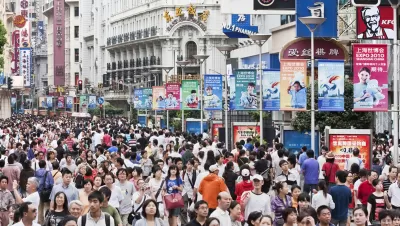For urbanization in China's cities to be truly human-centered, pedestrianization plans must be thoroughly considered.

According to Wei Li of the World Resources Institute, over 100 cities in China have at least one pedestrian-only street. Vibrant pedestrian-centric commercial centers are a long-held tradition in China's cities, where the word for "shopping" means "strolling around the streets." However, because efforts to improve walkability compete with the resource demands of economic modernization, pedestrianization tends to focus on the benefits to commercial development and tourism.
Li offers the Bund waterfront retrofit in Shanghai as a model of forward-thinking development that takes into consideration not only commercial goals but also the concerns of local pedestrians. The waterfront was previously blocked by 11 lanes of traffic and plagued with congestion of tourists and vehicles alike. "By removing seven lanes from the street, the project reduced 70 percent of vehicle traffic in the area. The project also tore down the elevated section of the highway and replaced it with crosswalks, increasing overall pedestrian connectivity."
With human-centered urbanization a hallmark of the current Five-Year Plan, Li feels "it is time for Chinese cities to design or redesign their streets for pedestrians in big ways."
FULL STORY: China’s Pedestrianization: Reviving a Tradition of Walking for Healthier Cities

Planetizen Federal Action Tracker
A weekly monitor of how Trump’s orders and actions are impacting planners and planning in America.

Congressman Proposes Bill to Rename DC Metro “Trump Train”
The Make Autorail Great Again Act would withhold federal funding to the system until the Washington Metropolitan Area Transit Authority (WMATA), rebrands as the Washington Metropolitan Authority for Greater Access (WMAGA).

The Simple Legislative Tool Transforming Vacant Downtowns
In California, Michigan and Georgia, an easy win is bringing dollars — and delight — back to city centers.

The States Losing Rural Delivery Rooms at an Alarming Pace
In some states, as few as 9% of rural hospitals still deliver babies. As a result, rising pre-term births, no adequate pre-term care and harrowing close calls are a growing reality.

The Small South Asian Republic Going all in on EVs
Thanks to one simple policy change less than five years ago, 65% of new cars in this Himalayan country are now electric.

DC Backpedals on Bike Lane Protection, Swaps Barriers for Paint
Citing aesthetic concerns, the city is removing the concrete barriers and flexposts that once separated Arizona Avenue cyclists from motor vehicles.
Urban Design for Planners 1: Software Tools
This six-course series explores essential urban design concepts using open source software and equips planners with the tools they need to participate fully in the urban design process.
Planning for Universal Design
Learn the tools for implementing Universal Design in planning regulations.
Smith Gee Studio
City of Charlotte
City of Camden Redevelopment Agency
City of Astoria
Transportation Research & Education Center (TREC) at Portland State University
US High Speed Rail Association
City of Camden Redevelopment Agency
Municipality of Princeton (NJ)




























